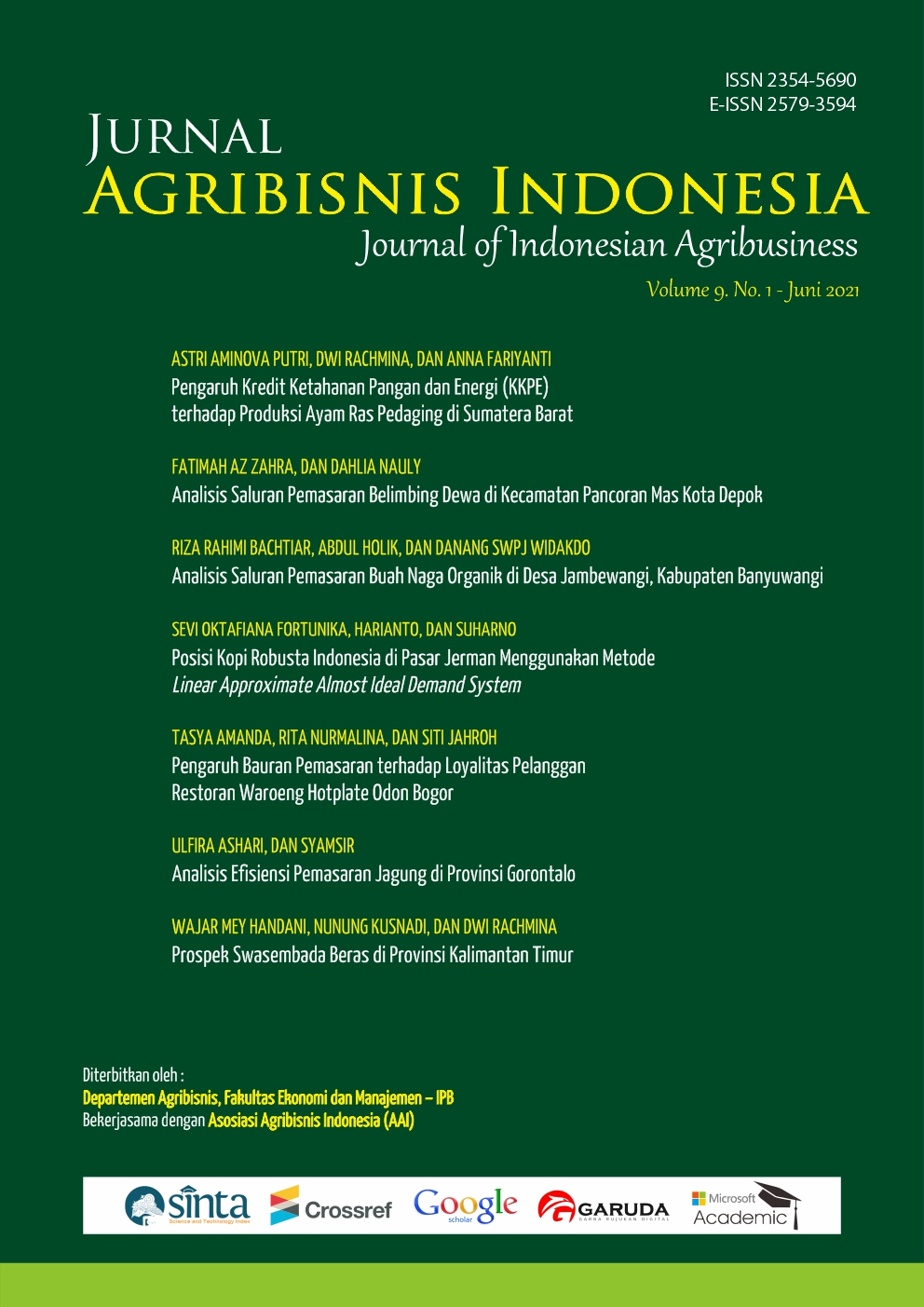Analisis Saluran Pemasaran Buah Naga Organik di Desa Jambewangi, Kabupaten Banyuwangi
Main Article Content
Abstract
Red dragon fruit is one of the strategic horticultural commodities that is growing rapidly in Banyuwangi because it has an exotic appearance and produces fruit that can be consumed. One area that cultivates organic red dragon fruit was Jambewangi. There were several problems in Jambewangi, such as farmers didn’t know profit distribution and cost’s share between marketing channels in organic red dragon fruit. The purpose of this study was to analyze the profit share and cost-share in Jambewangi. Determination of the research location used the purposive method and the method of determining the respondents used the snowball sampling method. The data used in this study are primary data and secondary data. The analysis used is the quantitative analysis used to measure the profit’s share and cost’s share. The results of the analysis can be concluded that the highest profit share value was found in channel 1 with 76.17% and the lowest cost share was also found in channel 1 with 23.83%. This result showed that channel 1 was the most efficient organic red dragon fruit marketing channel, compared to other marketing channels.
Downloads
Article Details
Jurnal Agribisnis Indonesia (JAI) is an Open Access Journal. The authors who publish the manuscript in this journal agree to the following terms:
Creative Commons License
JAI is licensed under a Creative Commons Attribution 4.0 International License. This permits anyone to copy, redistribute, remix, transmit, and adapt the work provided the original work and source are appropriately cited.
This means:
(1) Under the CC-BY license, authors retain ownership of the copyright for their article, but authors grant others permission to use the content of publications in Jurnal Agribisnis Indonesia in whole or in part provided that the original work is properly cited. Users (redistributors) of JAI are required to cite the original source, including the author's name, JAI as the initial source of publication, year of publication, volume number, issue, and Digital Object Identifier (DOI); (2) Authors grant JAI the right of first publication. Although authors remain the copyright owner.
References
Badan Pusat Statistik. 2018. BanyuwangiDalam Angka. Badan Pusat Statistik Kabupaten Banyuwangi.
Hardjadinata. 2010. Budidaya Buah Naga Super Red Secara Organik. Jakarta : Penebar Swadaya.
Jumiati, E, Darwanto, D.H, Hartono,S; Masyhuri. 2013. Analisis Saluran Pemasaran dan Marjin Pemasaran Kelapa Dalam di Daerah Perbatasan Kalimantan Timur. Jurnal Agrifor.XII (1):1-21.
Muhajir, Noeng. 1996. Metode Penelitian Kualitatif. Yogykarta : Rake Serasia.
Purwono, J., Sugyaningsih, S., Fajriah, N. 2014. Analisis Tataniaga Bunga Krisan di Kecamatan Cugenang Kabupaten Cianjur. Jurnal Neo-Bis. 8 (2): 132- 146.
Purwono, J., Sugyaningsih, S., Priambudi, A. 2013. Analisis Tataniaga Beras di Kecamatan Rogojampi Kabupaten Banyuwangi. Jurnal Neo-Bis. 7 (2): 2-15.
Puspitasari, T. 2017. Analisis Keberlanjutan Good Agriculture Practice (GAP) Usahatani Buah Naga di Desa Jambewangi Kecamatan Sempu Kabupaten Banyuwangi. [skripsi]. Jember: Universitas Jember.
Sugiyono. 2017. Metode Penelitian Kuantitatif, Kualitatif, R&D. Bandung: Alfabeta.
Suherman, T., Fauziyah, E., Hasan, F. 2011. Analisis Pemasaran Garam Rakyat (Studi Kasus Desa Kertasada, Kecamatan Kalianget, Kabupaten Sumenep). Embryo. 8 (2): 73-81.
Tiyas, A., Putra, I.G.S.A., dan Dewi, I.A.L.2015. Analisis Finansial Usahatani Buah Naga Super Merah (Hylocereuus costaricensis) (Studi Kasus Di Kelompok Tani Berkah Desa Sambirejo Kecamatan Bangorejo Kabupaten Banyuwangi). EJurnal Agribisnis dan Agrowisata. 4 (5): 402-411.
Utami, P dan Budiningsih, S. 2007. Analisis Efisiensi Saluran Pemasaran Salak Pondoh (Studi Kasus di Desa Sigaluh Kecamatan Banjarnegara). Agritech. 9 (10): 94-108.
Widiastuti dan Harisudin. 2013. Saluran dan Marjin Pemasaran Jagung di Kabupaten Grobogan. SEPA. 9 (2): 231-240.

